6 Effective Remedies for Treating Cold Sores

Cold sore is the infection around the lips caused by herpes simplex virus. It creates tiny fluid-filled lesions on or around the lips. Usually, cold sores affect people in the age of 14 to 60 years. The most common symptoms of a cold sore are a burning sensation in or on the skin, accompanied by sore lips, tingling lips, or ulcer, blisters, rashes, ulcers, or redness. This virus can quickly spread through physical contact.
Generally, self-diagnosable, this virus which causes cold sores are found in 90% of the population, but in most of the cases, it is harmless. When this virus becomes active, it causes oral herpes or cold sores. Even in its inactive state, this virus remains in the body.
The infection caused by the herpes simplex virus can recur at any point in the future depending upon the levels of stress, hormonal imbalance, and various other factors.
The treatment for cold sores aims to reduce or suppress the pain and discomfort, however, there is no cure for it. Read on to find out some at-home cold sore treatments to alleviate the symptoms.
- Ice packs
Ice packs help you to reduce the swelling and inflammation caused by the cold sores by numbing the nerves in and around the affected area. This reduces the pain caused due to the blisters. Just apply an ice cube over the troubled area thrice a day to get instant relief. Do not extend the application for more than 20 minutes as it can cause damage to the skin. - Aloe vera gel
Aloe vera is the most commonly used cosmetic product which is anti-inflammatory and has soothing properties for the skin. The redness and itchiness caused due to the blisters can be calmed down by applying aloe vera gel topically. For best results, freeze a scoop of aloe vera in the refrigerator and apply this aloe vera ice cube to the affected part at least twice a day. This will ensure both soothing and cooling of the affected area. - Lemon balm
Lemon balm (Melissa officinalis) is a member of the mint family. It is known for its calming properties. It can be useful in reducing the redness and swelling of the lips and the area around the mouth due to its anti-inflammatory qualities. Lemon balm can be applied topically by preparing a concentrated tea with water. Alternatively, you can buy a lip balm containing lemon balm to soothe the tense part around the mouth and lips. - Sunscreen
A sunscreen protects the skin from the harmful UV rays of the sun. During a cold sore, the lips are already inflamed, and the surface around them is irritated. To prevent the sun rays from creating further damage and causing rashes and redness, you should apply a sunscreen to near your mouth. It creates a good barrier between the sun and the tender skin, giving it time to heal and recover. - Stress management
Preventing a future cold sore flare up is as important as treating it after it has already attacked you. Taking care of your health to avoid the possible danger is the best way you can ensure you can escape the ill effects of a cold sore. Stress is one of the most common causes of frequent cold sore flare-ups. Therefore, it is crucial that you learn to channel it in a better manner. Engage in a regular exercise routine to control and manage your stress levels and lead a healthy lifestyle. Engage in de-stressing activities, games, and other things to elevate your mood. - Medicines
Commonly, the cold sores heal by themselves within 4-5 days. But, if you have a persistent problem or if the flare-ups happen very often throughout the year, you can consult a physician and can start prescription drugs which will offer you instant relief from the symptoms of a cold sore. It will also help limit flare-ups in the future. One of the best treatment available for cold sore treatment are medications having nucleosides and nucleotide analogs, which block viral reproduction. Several OTC antiviral medications are available in pharmacies. These medicines contain docosanol or benzyl alcohol which reduce the inflammation and redness caused by the virus and decrease the duration of the cold sore. Pain relievers containing ibuprofen or acetaminophen can assist if you are experiencing severe pain and tenderness in the affected area.
However, it is essential that you first consult a doctor for any prescription drugs. It is also advised that you avoid unwarranted consumption of OTC medications. If you seem unsure about its dosage patterns, then you should consult your physician.


